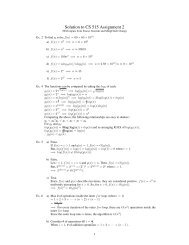The Linux Development Platform Configuring, Using, and ... - Classes
The Linux Development Platform Configuring, Using, and ... - Classes
The Linux Development Platform Configuring, Using, and ... - Classes
You also want an ePaper? Increase the reach of your titles
YUMPU automatically turns print PDFs into web optimized ePapers that Google loves.
AppA.fm Page 278 Monday, October 7, 2002 9:19 PM<br />
278 Appendix A • Typical Hardware Requirements for a <strong>Linux</strong> <strong>Development</strong> Workstation<br />
Externally there are things such as the keyboard <strong>and</strong> the mouse that permit the user to<br />
enter data into the system, <strong>and</strong> the monitor which enables the computer to present information in<br />
a way that the operator can easily underst<strong>and</strong>.<br />
When evaluating a new computer system, remember that the motherboard, the processor<br />
<strong>and</strong> the memory determine how fast your computer will be able to perform the tasks required of<br />
it.<br />
<strong>The</strong> hard disk drives, the network <strong>and</strong> video cards, etc. determine what <strong>and</strong> how much<br />
your computer will be able to do. However, speed of hard drive is also a major factor in overall<br />
speed of compilation in case your computer is low on memory.<br />
Lastly, the input <strong>and</strong> output devices determine how much style your computer will have<br />
while it goes about doing whatever it was told to do.<br />
While there is some overlap in function, these definitions provide a general outline of the<br />
parts of the computer <strong>and</strong> can give us a basis for determining a base-line system.<br />
A.2 Section 1—<strong>The</strong> Processor <strong>and</strong> Memory<br />
Systems are available with one or multiple processors. R<strong>and</strong>om Access Memory (RAM) is presently<br />
cheap <strong>and</strong> easy to find. Processor speed seems to double every eighteen months <strong>and</strong> almost<br />
as soon as a new system is purchased, it becomes obsolete.<br />
<strong>The</strong> speed <strong>and</strong> the number of processors will determine the sheer raw power that a computer<br />
has. Speed is measured in megahertz (MHz) <strong>and</strong> more is always better.<br />
<strong>The</strong> memory that a system has installed will also effect the overall speed of the computer.<br />
If the system runs out of physical memory, it will, if the space has been set aside for it, start paging<br />
memory to disk. This is the process of writing a portion of memory that has not been used<br />
recently (in computer terms that could mean milliseconds) to the disk in order to free the memory<br />
up for more immediate usage. When the information on the disk is required again, the computer<br />
frees up physical memory <strong>and</strong> reads the data from the disk into that area.<br />
As the hard disk drive is several orders of magnitude slower than simply reading the information<br />
from memory, this slows down the entire computer as it waits for the information to be<br />
written <strong>and</strong> read from the drive. If your computer sits idle while there are large amounts of<br />
access to the disks, it is possible that the computer is low on memory <strong>and</strong> swapping to the disk.<br />
Adding more memory to the system should speed it up.<br />
A.3 Section 2—<strong>The</strong> Disk Drive<br />
At present, there are two main types of drives available on the market for personal computers:<br />
IDE <strong>and</strong> SCSI (pronounced “scuzzy”). <strong>The</strong> first <strong>and</strong> most common is the IDE drive. This is the<br />
type sold with most off-the-shelf workstations. A st<strong>and</strong>ard computer will be able to support up to<br />
four IDE drives at a time. <strong>The</strong>se drives may be hard drives, CD-ROMs, DVD drives or even tape<br />
drives. Once the maximum of four devices has been installed into the computer, no more may be<br />
added until one is removed. This <strong>and</strong> the fact that IDE drives have traditionally been slower than

















